A few from Goole as well as some from Hull. Comments welcome on any of these pictures.
28th July 2017
Taken from the swing bridge between Bridge Rd and South Bridge Rd at the entrance to West Dock. Shed 23 has since been demolished. Around the corner is Stanhope Dock, built in 1891 as the ‘New Extension Dock’. The dock had a crane capable of lifting railway wagons and emptying them into the hold of a ship before placing them back on the rails. Now the track ends at Bridge St, and West Dock is the only dock served by rail. At left is the bridge pit.
Berthed in Stanhope Dock is Jurgen, a 444 ton coaster built in Hamburg in 1956 and originally named Heinrich Knuppel; it then became Heinrich Raap in 1966 before being renamed Jurgen in 1966. It had capsized and been written off in 1971 while loading timber in Finland, but was salvaged and back in service the following year for a company registered in Limassol, Cyrpus. Its troubles did not end there and on 5th March 1986 half way between Boston and Antwerp it was in collision with a Yugoslav bulk carrier, MV Kotor in the North Sea around 40 miles off Walcheren Island at the mouth of the Scheldt Estuary. It sank and is still on the sea bottom in around 40 metres of water.
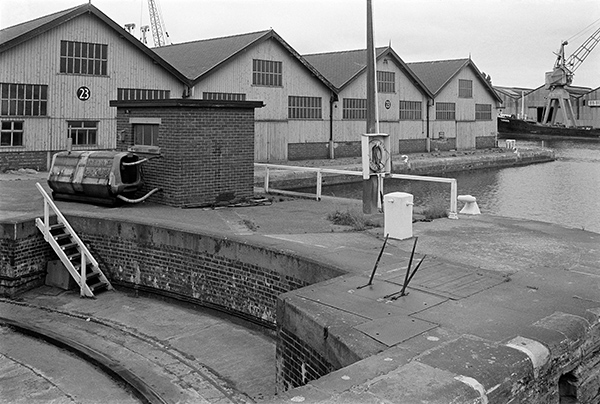
36h51: Shed 23, West Dock Entrance, Goole Docks, 1983 – Goole
29th July 2017
I think this door and windows were facing Bridge St on the west end of Shed 23 which was on the north side of the entrance to West Dock. The reflection in the window shows several cranes and stacks of timber, presumably across the road along the North side of West Dock.
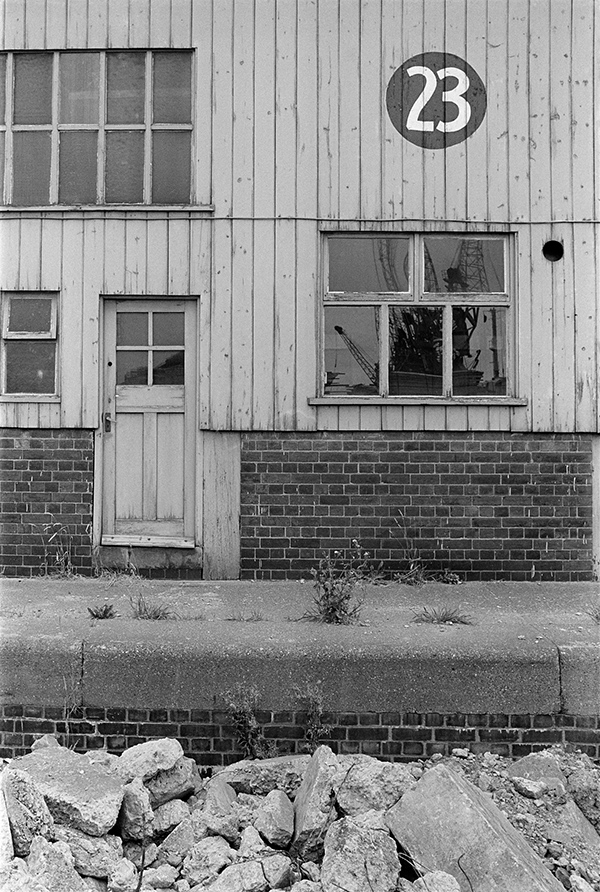
36h52: Detail, Shed 23, West Dock Entrance, Goole Docks, 1983 – Goole
30th July 2017
There is still a ‘Shed 20’ on the south side of West Dock, but it looks nothing like this. Along with most of the other sheds around the docks these old wooden structures have been replaced by more modern sheds. There are now two sheds here, Shed 20 and Shed 21, and I think this view was probably taken from Lower Bridge St and from the same position would now show Shed 21.
In the foreground are two conveyors, presumably used of the bulk handling of solids such as sand or gravel, and behind them a lorry load shrouded in a tarpaulin stencilled ‘Wrights Transport Goole’. Fred Wright started the business in Selby in 1938 and ran it with his brother Charles. It remained a family business, and Graham Wright took over in the 1960s, moving to Goole in 1978, and his two sons worked in the business, which was sold up in 2004 when Graham Wright retired. The auction raised £600,000.
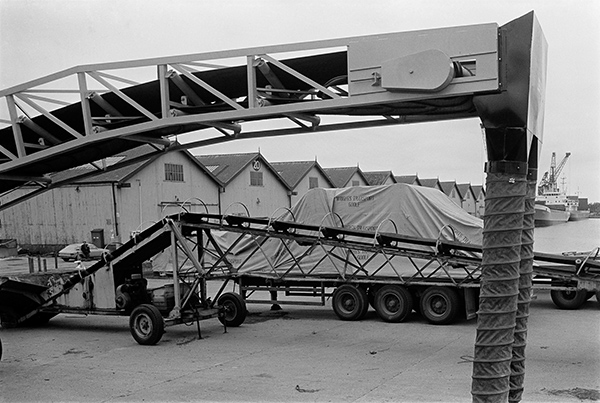
36h64: Shed 20, West Dock from Bridge St, Goole, 1983 – Goole
31st July 2017
A crane holds 4 sacks in mid-air over the hold of the Jurgen berthed in Stanhope DOck in front of Shed 25 while behind 2 men stand waiting on the platform of a lorry. They and the crane-driver are slowly loading or unloading the vessel, and it looks as if the job could take several days. It’s easy to see why containerisation rapidly swept away the old-fashioned ways of handling goods like this – and the modernisation of the docks has meant that the dockside sheds have also gone. The space where Shed 23 was is now empty, while a blander modern structure has replace Shed 25.
The Parish Church of St John the Evangelist is still there – and the very visible lightning conductor going up its spire to the cross on top may well have helped.
Shed 25 replaced the Lancashire & Yorkshire Railway “Ghent and Antwerp Shed” and Bergline began working from it in 1972, providing regular freight services to Sweden etc. The company appears now to have disappeared.
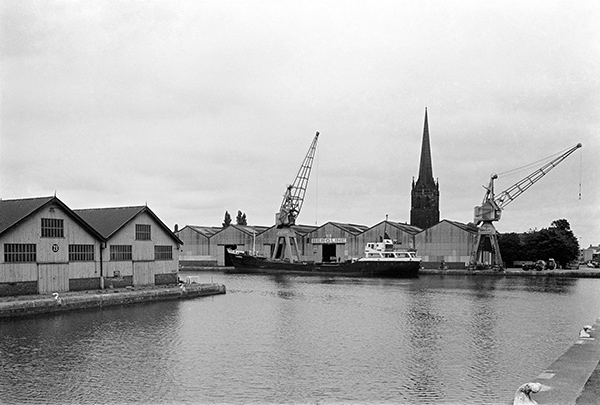
36h66: West Dock Entrance, Stanhope Dock, Shed 23 and Shed 25 from West Dock Bridge, 1983 – Goole
1st August 2017
I think I felt that the tilted camera was somehow appropriate for the dilapidated state of the pier when I took this picture. Or perhaps it was just grabbed rapidly as the seagulls flew off as I approached.
Rather than repairing the pier, a a layer of some kind of board had been nailed over part of it and a fence put up to stop people falling down the gaps outside. It perhaps reflected a general attitude of neglect and half-hearted attention to the heritage of the city.
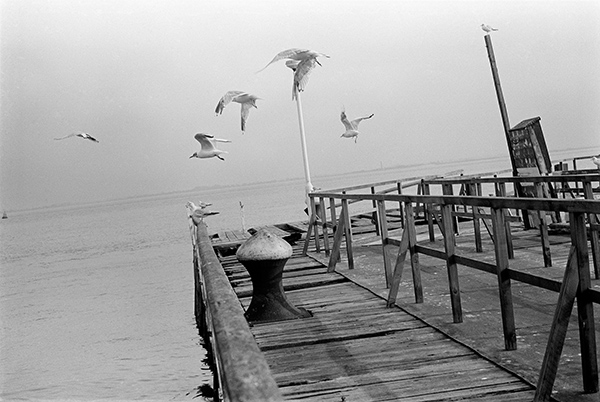
36i11: Seagulls at Hull Pier, 1983 – Old Town
2nd August 2017
Shifting mud in the River Humber makes navigation tricky and shops require pilots to make a safe passage up the river. The earliest UK laws about pilots date from around 1200 and members of Hull Trinity House, founded in 1369 were pilots, although it was not until 1512 that they formally undertook to act as pilots to bring ships into Hull. The Humber Pilot Act of 1800 gave Trinity House the authority to appoint pilots and 30 men working from 6 pilot boats were licenced.
From 1812 to 1998 the Humber pilots worked from a fine purpose-built office at 50 Queen St, but were evicted when this was turned into flats in 1998. In 2001, the independent Humber Pilots went on strike against plans by Associated British Ports (the private company who took over when British Transport Docks Board was privatised in 1982/3) who had decided to train and employ their own pilots. All 150 independent pilots had their licences revoked in 2002 ending 490 years of independent pilotage on the Humber.
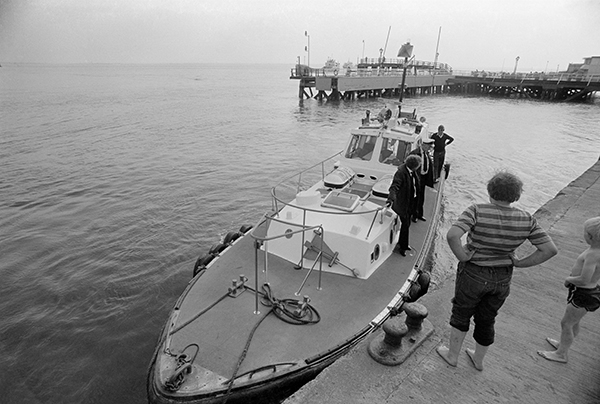
36i22: Pilot boat Camilla waiting at Nelson St, 1983 – Old Town
3rd August 2017
This view of the pilot boat was taken from the Horse Wash at Nelson St. The ‘Oss Wash’ is a wide fairly gently slope down to the river inset into the river wall here where tradesmen would bring their horses to wash them down, presumably drawing water from the Humber using buckets on a rope or even taking them down into the river to wash and then walk back up the wide slope. I think old photographs show some railings coming out at intervals from the river wall around half way across the wide slope to divide it into a number of stalls, but these had gone.
All ships greater than 60 metres in length are required to take on a pilot to ensure safe passage up the Humber estuary unless the master or first mate is a Pilotage Exemption Certificate Holder. This service, provided from 1512 to 2002 by independent Humber Pilots is now provided by the privatised Associated British Ports. Very Large Ships need two pilots
Fees depend on tonnage, and as an example, for a vessel of up to 300 tons there is a charge for pilotage from Hull to Goole of £267.39 and also a boarding/landing fee of £104.47. Larger vessels pay more.
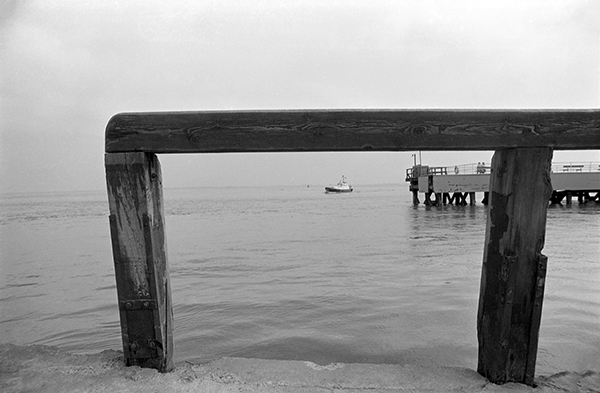
36i21: Humber pilot boat Camilla waits off Hull Pier, 1983 – Old Town
You can see the new pictures added each day at Hull Photos, and I post them with the short comments above on Facebook.
Comments and corrections to captions are welcome here or on Facebook.
______________________________________________________
There are no adverts on this site and it receives no sponsorship, and I like to keep it that way. But it does take a considerable amount of my time and thought, and if you enjoy reading it, a small donation – perhaps the cost of a beer – would be appreciated.
My London Diary : Buildings of London : River Lea/Lee Valley : London’s Industrial Heritage
All photographs on this and my other sites, unless otherwise stated, are taken by and copyright of Peter Marshall, and are available for reproduction or can be bought as prints.